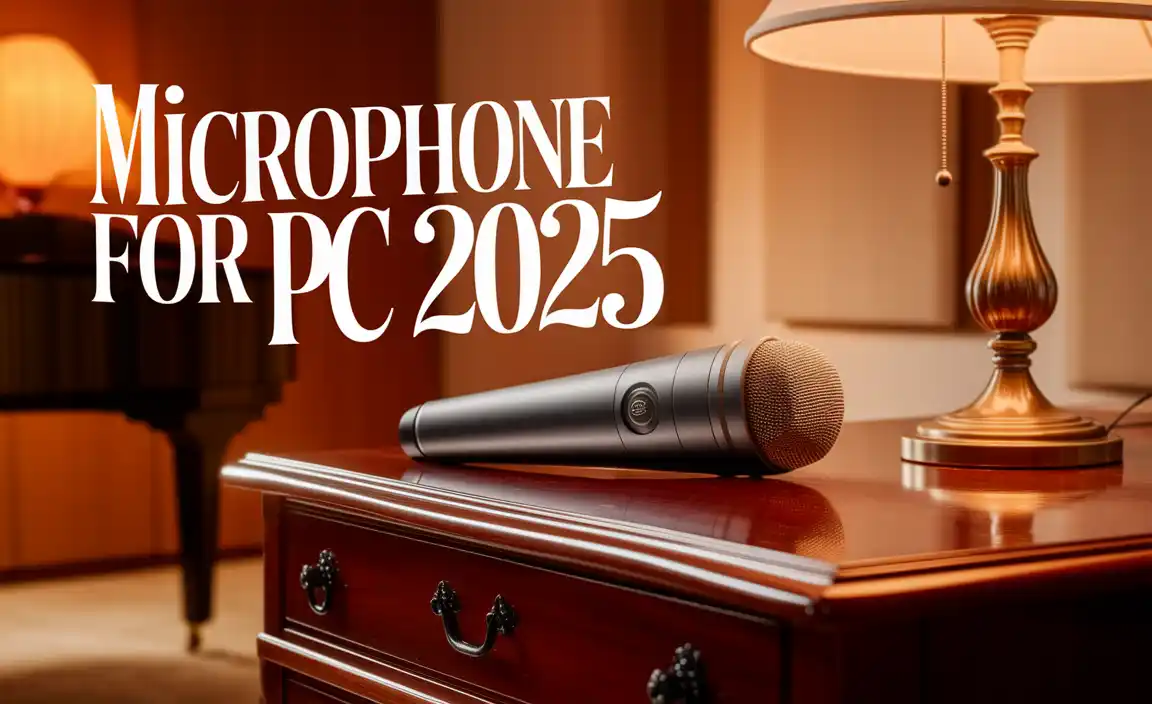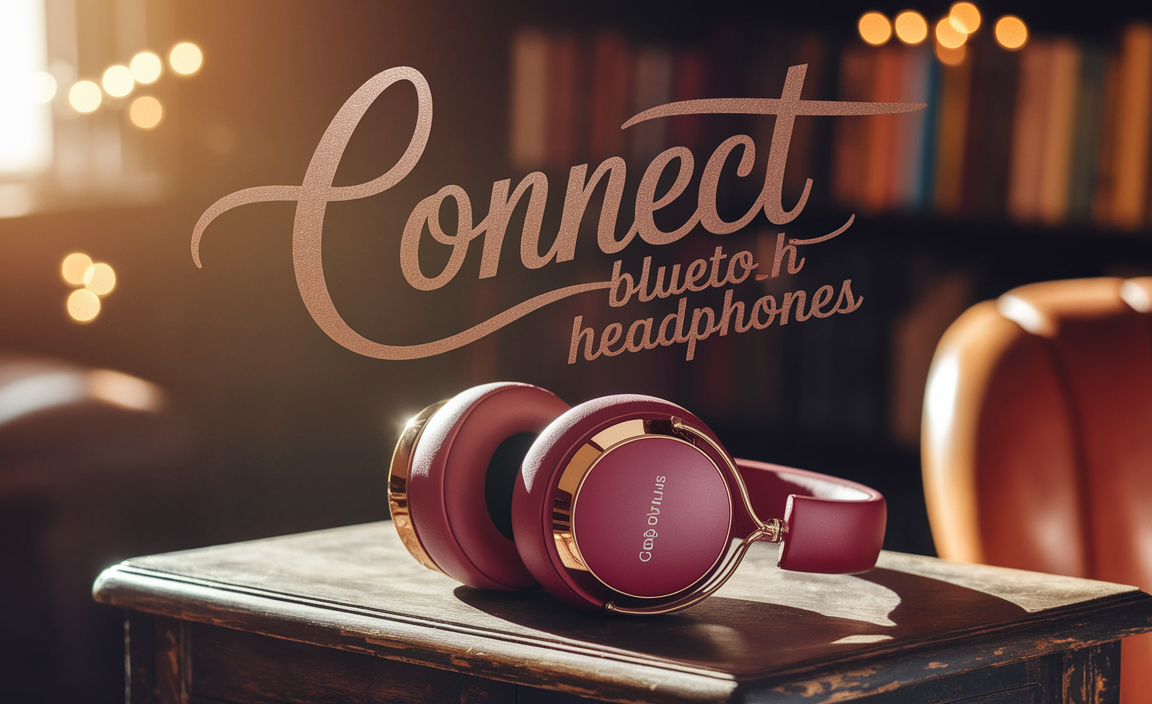Quick Summary:
Boost your TikTok game with the right microphone for your Android! From simple lavaliers to powerful shotgun mics, this guide helps you pick the best mic for clear audio, capturing every word and sound for viral-worthy content. Get ready for crystal-clear sound that will make your followers hit that like button.
Ever feel like your amazing TikTok videos are missing something? Often, it’s the sound! Your Android phone’s built-in microphone is decent, but for professional-sounding videos that grab attention, it’s often not enough. Background noise, muffled voices, and inconsistent audio can make viewers scroll right past. But don’t worry! Getting fantastic audio for your TikToks on an Android is easier than you think. We’ll walk you through everything you need to know, from understanding your options to picking the perfect mic that fits your style and budget. Let’s make your audio as awesome as your visuals!
Why a Dedicated Microphone is a TikTok Game-Changer for Android Users
You spend hours crafting the perfect TikTok – the visuals are stunning, your editing is on point, and your performance is a solid 10/10. But then you watch it back, and the audio is… meh. This is a common frustration for many Android creators. While smartphones have come a long way, their integrated microphones are designed for general use, not the specific demands of content creation. They often pick up ambient noise, struggle with voice clarity, and can sound distant, especially when you’re not right next to the phone.
Investing in an external microphone for your Android changes all of that. It’s like upgrading from a whisper to a clear announcement. A dedicated mic can significantly improve:
- Voice Clarity: Make sure your spoken words are crisp and easy to understand.
- Reduced Background Noise: Focuses on your voice and minimizes distracting sounds like traffic, wind, or room echo.
- Consistent Volume Levels: Ensures your audio isn’t too loud in some parts and too quiet in others.
- Directionality: Some mics can be pointed directly at your sound source, further isolating it.
- Professionalism: High-quality audio signals that you take your content seriously, which can lead to more engagement and followers.
Think of it this way: you wouldn’t paint a masterpiece with a crayon, right? Similarly, for polished TikToks, you need audio tools that match your ambition. Luckily, the market is packed with options for Android users, from simple plug-and-play devices to more advanced setups.
Understanding Microphone Types for Your Android TikTok Setup
Before diving into specific models, it’s crucial to understand the different types of microphones that work with Android phones. The connection method is key here, as Android phones primarily use USB-C ports for audio input. Some older models might still use a 3.5mm headphone jack (often shared with charging), but USB-C is the modern standard.
1. Lavalier Microphones (Lapel Mics)
These are small microphones that clip onto your clothing, typically near your collar. They are very popular for vlogging, interviews, and spoken-word content because they keep the microphone close to your mouth, ensuring clear capture of your voice while minimizing background noise.
- Pros: Portable, discreet, excellent for voice clarity, affordable options available, great in noisy environments.
- Cons: Can sometimes rustle against clothing, requires careful placement, wired versions can have limited freedom of movement.
2. Shotgun Microphones
Shotgun mics are directional microphones. They are designed to pick up sound from a specific direction (in front of the mic) and reject sound from the sides and rear. They are often mounted on top of a camera or boom pole for vlogging or film-style content.
- Pros: Highly directional, good for isolating sound, can be mounted to a phone rig or boom.
- Cons: Can be more expensive, less effective in very noisy winds without a windscreen, requires more deliberate aiming.
3. Wireless Microphone Systems
These systems consist of two parts: a transmitter (worn by the subject or attached to a microphone) and a receiver (connected to the Android phone). They offer the most freedom of movement and are ideal for creators who move around a lot.
- Pros: Maximum freedom of movement, great for dynamic content, can be very professional.
- Cons: Generally the most expensive option, requires pairing and battery management, potential for interference.
4. USB-C Microphones (Direct Plug-in)
Some microphones plug directly into your Android’s USB-C port. These can range from small, portable mics to more substantial desk-style microphones. They are often a good balance of quality and convenience.
- Pros: Simple plug-and-play, no extra adapters needed (if USB-C), good quality options available.
- Cons: Can be bulky depending on the model, might require access to the phone’s power if used for extended periods.
Choosing the Right Connector for Your Android Phone
This is arguably the most critical step for an Android user. Most modern Android phones rely on their USB-C port for all data, including audio. However, not all USB-C ports are created equal when it comes to analog audio support. Some phones have transitioned to digital audio only over USB-C and have dropped analog audio support entirely. This means you might directly plug in a USB-C microphone, or you might need an adapter.
USB-C vs. 3.5mm TRRS
- USB-C: This is the modern standard. Many microphones will have a USB-C connector that plugs directly into your phone. Some might provide a USB-C to USB-A adapter if the mic itself has a USB-A output.
- 3.5mm TRRS: This is the traditional headphone jack, but for microphones and headsets, it uses a TRRS (Tip, Ring, Ring, Sleeve) connector. It carries both microphone input and stereo audio output. If your Android phone still has a headphone jack, you can use microphones with 3.5mm TRRS plugs.
What if My Phone Only Has USB-C and No Headphone Jack?
This is where things can get tricky, but solutions exist! Most USB-C microphones will work directly by sending a digital audio signal. If you have a microphone that only has a 3.5mm jack, you will likely need a USB-C to 3.5mm adapter. These adapters convert the digital signal from your phone’s USB-C port to an analog signal that the microphone can use. Look for adapters specifically designed for microphone or headset input. Not all USB-C to 3.5mm adapters are created equal; some are designed purely for audio output (speakers/headphones).
Pro Tip: Always check your phone’s specifications or do a quick online search for “[Your Phone Model] USB-C audio support” to understand its capabilities. Websites like GSMArena often list detailed specs for most phones, which can be helpful.
Essential Features to Look For in an Android TikTok Microphone
Beyond the type and connector, several features can make or break your audio experience. Here’s what to consider:
1. Polar Pattern
This describes the microphone’s directionality. For TikTok, you’ll most commonly want:
- Cardioid: Picks up sound from the front, rejects from the sides and rear. Perfect for solo creators talking to the camera.
- Omnidirectional: Picks up sound equally from all directions. Useful if you’re capturing ambient sounds or group conversations, but less ideal for isolating your voice in a noisy place.
2. Frequency Response
This is the range of frequencies (bass to treble) a microphone can capture. A wider, flatter response generally means more natural sound. For voice, you want a mic that captures the “presence” frequencies (around 2-5kHz) clearly.
3. Signal-to-Noise Ratio (SNR)
A higher SNR means less self-noise (the inherent hiss or hum of the microphone circuit) in your recordings. Aim for microphones with an SNR of 70dB or higher for cleaner audio.
4. Connectivity Options
As discussed, USB-C is primary. However, some mics might also offer Bluetooth connectivity, though this can sometimes introduce latency (delay), which isn’t ideal for real-time video recording. Some professional mics might come with XLR outputs, requiring an adapter/interface to connect to your Android.
5. Durability and Build Quality
If you’re out and about filming, your microphone needs to withstand some bumps. Metal construction is generally more durable than plastic.
6. Included Accessories
Does it come with a windscreen (for wind noise reduction), a shock mount (to reduce handling noise), a cable for your specific phone, or a carrying case? These can add significant value.
Top Microphone Recommendations for Android TikTok Creators (Budget-Friendly to Mid-Range)
Finding the “best” microphone is subjective and depends on your specific needs and budget. However, here are some popular and well-regarded options that are great for Android users looking to step up their TikTok audio game:
| Microphone Model | Type | Connection | Key Features | Best For |
|---|---|---|---|---|
| Rode Wireless GO II (with optional SC15 USB-C cable) | Wireless Lavalier System | USB-C (via SC15 cable), 3.5mm TRS (receiver) | Excellent audio quality, reliable wireless transmission, built-in recorder, versatile. | Creators needing maximum freedom and top-tier wireless audio for interviews, vlogs, or performances. |
| BOYA BY-WM3T2-U3 (or similar USB-C variant) | Wireless Lavalier System | USB-C (receiver) | Affordable, compact, plug-and-play, good for basic wireless spoken word. | Budget-conscious users wanting simple wireless lavalier for clear voiceovers or talking head videos. |
| Rode SmartLav+ | Wired Lavalier | 3.5mm TRRS (requires adapter for most USB-C phones) | Professional-grade sound for a wired mic, durable, clear voice capture. | Creators who prioritize vocal clarity and don’t mind being tethered (or using a reliable adapter/extension). |
| Deity V-Mic D3 Pro | Camera-Top Shotgun | 3.5mm TRRS (requires adapter for most USB-C phones) | Excellent off-axis rejection, great sound, analog input, durable build. | Filmmakers and vloggers who want a directional mic for enhanced audio isolation and quality. |
| Sennheiser MKE 400 | Compact Shotgun | 3.5mm TRS (receiver, works with appropriate adapters) | Directional sensitivity, built-in windscreen and shock mount, good for on-the-go. | Mobile creators needing a compact, directional mic that attaches easily to their phone rig. |
| Rode VideoMic Me-C | Compact Directional (Plug-in) | USB-C | Direct USB-C connection, easy to use, compact, decent directional audio. | Beginners looking for a simple, direct-plugging directional mic solution for their USB-C Android. |
Important Considerations for Android Compatibility:
- Check for TRRS vs. TRS: Many mics designed for cameras have a 3.5mm TRS output. For Android phones (even with an adapter), you usually need a TRRS input. A specific adapter might be needed.
- USB-C Requirements: Some very high-end or older USB-C microphones might require specific drivers or have compatibility issues with certain Android versions or phone brands. Always check reviews or the manufacturer’s website.
- App Support: While most Android phones will recognize external microphones automatically, some apps might require specific settings or might only work with certain mic types. The native TikTok app is generally very compatible.
How to Connect Your Microphone to Your Android Phone for TikTok
Connecting your new microphone is usually straightforward, but the exact steps depend on the type of microphone you have.
For Wired Microphones (Lavalier or Shotgun) with 3.5mm TRRS Connector:
- Ensure your Android phone has a 3.5mm headphone jack.
- Plug the microphone’s 3.5mm TRRS connector directly into your phone’s headphone jack.
- Open the TikTok app and navigate to the camera screen to record. Your phone should automatically switch to the external microphone. You can test this by recording a short clip and listening back.
For Wired Microphones with 3.5mm TRS Connector (Camera Mics):
- You will likely need a 3.5mm TRS to 3.5mm TRRS adapter cable. This adapter converts the stereo output of the mic to the mono input your phone expects.
- First, plug the TRS end of the adapter into your microphone.
- Then, plug the TRRS end of the adapter into your Android phone (either headphone jack if available, or into a USB-C to 3.5mm adapter).
- Open TikTok and test your audio.
For USB-C Microphones:
- Find the USB-C cable that comes with your microphone (or a compatible USB-C to USB-C cable).
- Plug one end into the microphone and the other end directly into your Android phone’s USB-C port.
- The phone should recognize the microphone automatically.
- Open TikTok and check your audio.
For Wireless Microphone Systems:
- Pair the Transmitter and Receiver: Follow the manufacturer’s instructions to pair the transmitter (worn by you) with the receiver.
- Connect the Receiver to Your Phone: The receiver unit will typically have an output. This could be a 3.5mm jack or a USB-C connector.
- If it has a 3.5mm output, connect it to your phone’s headphone jack or via a USB-C to 3.5mm adapter.
- If it has a USB-C output, connect it directly to your phone’s USB-C port.
- Power On and Test: Turn on both the transmitter and receiver. Open TikTok and record a test clip to ensure the audio is coming through clearly.
Tips for Getting the Best Audio Quality on TikTok with Your Android Mic
Even with a great microphone, a few best practices can elevate your TikTok audio from good to outstanding.
- Minimize Background Noise: Film in the quietest environment possible. Turn off fans, close windows, and ask others to be quiet if you’re filming indoors.
- Mic Placement is Key:
- For lavalier mics: Clip it to your shirt collar, about 6-8 inches from your mouth. Avoid placing it over loose clothing that can
- For lavalier mics: Clip it to your shirt collar, about 6-8 inches from your mouth. Avoid placing it over loose clothing that can






